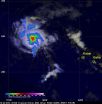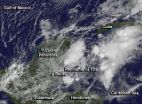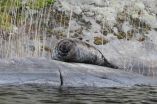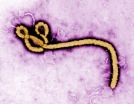NASA sees Tropical Storm Ana still vigorous
2014-10-24
(Press-News.org) NASA's TRMM satellite saw that Tropical Storm Ana was still generating moderate rainfall is it pulled away from Hawaii. The next day, NASA's Aqua satellite saw that wind shear was having an effect on the storm as it moved over open ocean.
On Oct. 24, Ana had moved far enough away from land areas that there were no watches or warnings in effect.
The Tropical Rainfall Measuring Mission (TRMM) satellite flew over tropical storm Ana on October 22, 2014 at 1935 UTC (about 8:30 a.m. HST local time). Ana formed over ten days ago but after moving to the northwest of the Hawaiian islands the tropical storm was shown to be still vigorous. A rainfall analysis from TRMM's Microwave Imager (TMI) revealed an area near Ana's center of circulation where rain was falling at a rate of over 40 mm (about 1.6 inches) per hour. TRMM is managed by NASA and the Japan Aerospace Exploration Agency.
NASA's Aqua satellite passed over Tropical Storm Ana on Oct. 24 at 00:25 UTC (Oct. 23 at 8:25 p.m. EDT) and the Moderate Resolution Imaging Spectroradiometer captured a visible image of the storm. The MODIS image showed that there was weak north to north-northwest vertical wind shear that was pushing the clouds and showers away from the center. The MODIS image showed some deep convection and developing thunderstorms mainly along its southeastern semicircle.
On Friday, Oct. 24 at 5 a.m. EDT (0900 UTC/11 p.m. HST, Oct. 23) the center of tropical storm Ana was located near latitude 27.9 north and longitude 170.1 west. That's about 365 miles (585 km) northwest of French Frigate Shoals and 890 miles (1,435 km). Maximum sustained winds were near 50 mph (85 kph). NOAA's Central Pacific Hurricane Center noted that Ana may intensify slightly on Friday, but little significant change in intensity was forecast over the weekend of Oct. 25-26.
Ana is moving toward the north-northwest near 8 mph (13 kph). Ana is expected to begin moving toward the north with a gradual increase in forward speed later tonight and Friday. A rapid acceleration of Ana toward the northeast is expected this weekend.
The Joint Typhoon Warning Center (JTWC) predicts that Ana will continue to move over open waters and undergo extra-tropical transitioning in the next couple of days. By early next week, Oct. 28 or 29 the JTWC expects Ana to be absorbed by a strong extra-tropical low pressure area that is forecast to approach British Columbia, Canada.
INFORMATION:
Rob Gutro/Hal Pierce
NASA's Goddard Space Flight Center/SSAI
[Attachments] See images for this press release:


ELSE PRESS RELEASES FROM THIS DATE:
2014-10-24
BUFFALO, N.Y. -- When partnering with larger companies, startups with a small number of carefully chosen alliances will reap the most benefits, according to new research from the University at Buffalo School of Management.
Forthcoming in Organization Science, the study found that by aligning with established companies, a young firm gains valuable access to additional resources and markets. However, as a startup adds more outside partners, eventually the firm's internal capability will weaken and the cost of maintaining its alliances will exceed any remaining benefits.
"Partnerships ...
2014-10-24
NOAA's GOES-East satellite has been keeping an eye on the remnants of Tropical Depression 9.
On Oct. 24 at 14:30 UTC (10:30 a.m. EDT) GOES-East captured a visible image of clouds and thunderstorms associated with former Tropical Depression 9,, centered over the southeastern Yucatan Peninsula of Mexico, Belize, and the adjacent northwestern Caribbean Sea.
NOAA's National Hurricane Center (NHC) noted that surface pressures were rising in the area, and the re-development of the former depression is unlikely. The remnants are expected to continue moving east over the ...
2014-10-24
Endurance athletes taking part in triathlons are at risk of the potentially life-threatening condition of swimming-induced pulmonary oedema. Cardiologists from Musgrove Park Hospital, Taunton, writing in the Journal of the Royal Society of Medicine, say the condition, which causes an excess collection of watery fluid in the lungs, is likely to become more common with the increase in participation in endurance sports. Increasing numbers of cases are being reported in community triathletes and army trainees. Episodes are more likely to occur in highly fit individuals undertaking ...
2014-10-24
A survey published this year found that over 50% of final year veterinary students in the UK do not feel confident either in discussing orodental problems with clients or in performing a detailed examination of the oral cavity of their small animal patients.1 Once in practice, things don't always improve and, anecdotally, it seems many vets dread feline dental procedures.
UK-based practitioners, Rachel Perry and Elise Robertson, who themselves felt woefully ill-prepared for feline dentistry as new graduates, have joined forces in an initiative to plug this educational ...
2014-10-24
The Ebola epidemic is continuing to spread, particularly in West Africa. According to the latest report by the World Health Organisation (WHO) dated 17 October, 9,216 cases of Ebola have been recorded and 4,555 people have died of the virus.
With the current situation of the Ebola epidemic, it quickly became necessary for French research to be mobilised rapidly.
In August 2014, the French Minister of Health and Secretary of State for Higher Education and Research made Aviesan responsible for preparing and organising the response of French research to infectious emergencies. ...
2014-10-24
A collaboration between researchers at the Universities of Leicester and Innsbruck has developed a completely new way of forming charged molecules which offers tremendous potential for new areas of chemical research.
Professor Andrew Ellis from our Department of Chemistry has been working for several years with colleagues at the Institute of Ion Physics in Austria on exploring the chemistry of molecules inside liquid helium. The team's latest and most startling discovery is that helium atoms can acquire an excess negative charge which enables them to become aggressive ...
2014-10-24
The critically endangered Saimaa ringed seal, which inhabits Lake Saimaa in Finland, has extremely low genetic diversity and this development seems to continue, according to a recent study completed at the University of Eastern Finland. In her doctoral dissertation, Mia Valtonen, MSc, analysed the temporal and regional variation in the genetic diversity of the endangered Saimaa ringed seal. The population is only around 300 individuals divided into smaller sub-populations and with very little migration among between them.
The study developed a method allowing the identification ...
2014-10-24
BUFFALO, N.Y. — A new study is helping to rewrite Ebola's family history.
The research shows that filoviruses — a family to which Ebola and its similarly lethal relative, Marburg, belong — are at least 16-23 million years old.
Filoviruses likely existed in the Miocene Epoch, and at that time, the evolutionary lines leading to Ebola and Marburg had already diverged, the study concludes.
The research was published in the journal PeerJ in September. It adds to scientists' developing knowledge about known filoviruses, which experts once believed came ...
2014-10-24
Adherent cells, the kind that form the architecture of all multi-cellular organisms, are mechanically engineered with precise forces that allow them to move around and stick to things. Proteins called integrin receptors act like little hands and feet to pull these cells across a surface or to anchor them in place. When groups of these cells are put into a petri dish with a variety of substrates they can sense the differences in the surfaces and they will "crawl" toward the stiffest one they can find.
Now chemists have devised a method using DNA-based tension probes to ...
2014-10-24
Tempe, Ariz. (Oct. 23, 2014) - New research findings from a team of prevention scientists at Arizona State University demonstrates that a family-focused intervention program for middle-school Mexican American children leads to fewer drop-out rates and lower rates of alcohol and illegal drug use.
"This is the first randomized prevention trial that we're aware of to show effects on school dropout for this population," said Nancy Gonzales, Foundation Professor in the REACH Institute and Psychology Department, College of Liberal Arts and Sciences at Arizona State University. ...
LAST 30 PRESS RELEASES:
[Press-News.org] NASA sees Tropical Storm Ana still vigorous





